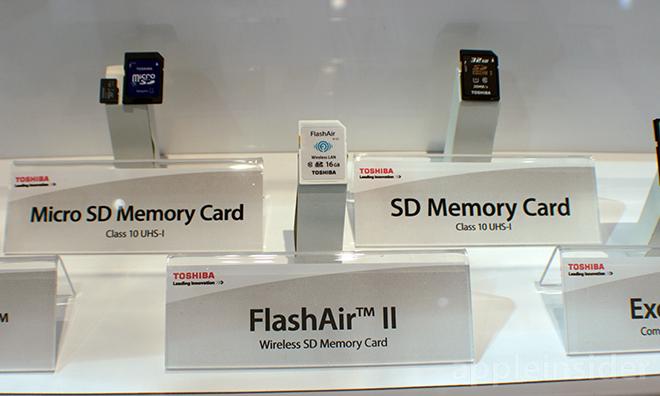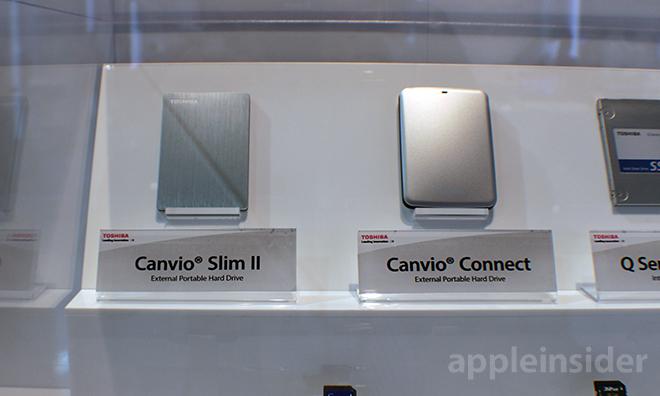Japanese computing giant Toshiba brought a few interesting products to the show floor this year with its updated FlashAir II Wi-Fi-enabled SD card, Canvio Connect portable wireless HDD and Canvio Slim.
One of the more interesting products Toshiba had on display was a wireless SD card called the FlashAir II, which is already available from resellers like Amazon.
Comparisons will immediately be drawn to Eye-Fi's series of products meant to add instant Wi-Fi capabilities to a user's digital camera, but from what we saw, the Toshiba version looks to be a better value.
The Class 6 NAND-based FlashAir II creates its own Wi-Fi hotspot that supports up to seven simultaneous hosts, meaning stored data can be shared with a cluster of smartphones, tablets and PCs. In addition, the device is browser-based, allowing for OS independence.
Available now, the 16GB and 32GB versions of FlashAir II retail for $79 and $99, respectively. Purchasing through resellers brings the price down to $51 for the 16GB model and $61 for the 32GB iteration.
Toshiba's Internet-connected Canvio Connect is also on sale now and offers wireless data transfer to both Windows and Mac machines. Out of the box, the Connect is formatted as NTFS, but comes with a Mac driver for read/write operations. The result is a solid cross-platform solution.
"The other thing it does is, for the Windows users, is the connect function means that it works with Pogoplug [cloud storage service], and we include the service for that," said Toshiba's Bill Monroe. AppleInsider was able to confirm the Canvio Connect also supports Pogoplug on Mac. "If it's connected to a computer and online, you can access that data from your phone, including the Pogoplug iOS app, and other laptops anywhere in the world."
The 1TB Canvio Connect comes with a free downloadable copy of Pogoplug with 10B of cloud storage for $65, while a 2TB version can be had for $88. Other capacities are also available.
Finally, the Canvio Slim II eschews wireless connectivity for a smaller form factor. Pre-formatted for Windows or Mac, the Slim II transfers data over the speedy USB 3.0 protocol. Additionally, the brushed aluminum case makes it a good match for Apple's latest Macs.
The Canvio Slim II comes in 500GB and 1TB capacities. The lower model can be had for a price of $72, but Amazon sells the 1TB version for only $80.
 Victor Marks
Victor Marks








-m.jpg)






 Marko Zivkovic
Marko Zivkovic
 Christine McKee
Christine McKee
 Andrew Orr
Andrew Orr
 Andrew O'Hara
Andrew O'Hara
 William Gallagher
William Gallagher

 Mike Wuerthele
Mike Wuerthele
 Bon Adamson
Bon Adamson




-m.jpg)



15 Comments
Someone at AI needs to proof read this story.
I wish someone could make this into a micro SD card so I can make the Samsung Galaxy camera useable without their terrible software and the fact that wireless transfer doesn't actually work.
[quote name="Evilution" url="/t/161533/first-look-toshibas-flashair-ii-wi-fi-sd-card-and-canvio-portable-storage#post_2456470"]I wish someone could make this into a micro SD card so I can make the Samsung Galaxy camera useable without their terrible software and the fact that wireless transfer doesn't actually work.[/quote] My dad got a Samsung "Smart Camera." He calls it a dumb camera. Says they have no idea how to make cameras, unlike brands like Nikon and Canon.
Anyone tried this product here yet? Class 10 doesn't tell me enough and I can't find the X speed anywhere. I've only used ScanDisk 95 MB/s UHS-1 cards for my Canons which are also a class 10. I suspect the price of these means they are nowhere near that kind of speed but I could be wrong. I've also read the software to control this card and its download has to be from the manufacturer, I'd want to be able to use OS X wifi directly and therefore work with Photo Stream if wished and be able to access via Aperture directly not via some 3rd part application, although I accept to access and set up passwords one time only that might be necessary. Something tells me none of this will be possible ... (but I'd love to know if I'm wrong) ... Perhaps this is something Apple should look into, partnering with a Flash Card manufacturer to make a true Apple product that 'just works'. Meanwhile .... talking of Aperture ... Please Apple, update Aperture for the Mac Pro! .... I am seeing virtually no difference between using a 2009 MacBook Pro i7(fitted with SDD) and a new Mac Pro . The same goes for 3rd part plug ins for Aperture so please will these companies pull out their fingers too. If Aperture and its plug ins were tuned to use the GPU the way FCPro X is, we'd be able to work exponentially faster with photo shoots.
Anyone tried this product here yet? Class 10 doesn't tell me enough and I can't find the X speed anywhere. I've only used ScanDisk 95 MB/s UHS-1 cards for my Canons which are also a class 10. I suspect the price of these means they are nowhere near that kind of speed but I could be wrong. I've also read the software to control this card and its download has to be from the manufacturer, I'd want to be able to use OS X wifi directly and therefore work with Photo Stream if wished and be able to access via Aperture directly not via some 3rd part application, although I accept to access and set up passwords one time only that might be necessary. Something tells me none of this will be possible ... (but I'd love to know if I'm wrong) ...
Perhaps this is something Apple should look into, partnering with a Flash Card manufacturer to make a true Apple product that 'just works'.
Meanwhile .... talking of Aperture ... Please Apple, update Aperture for the Mac Pro! .... I am seeing virtually no difference between using a 2009 MacBook Pro i7(fitted with SDD) and a new Mac Pro . The same goes for 3rd part plug ins for Aperture so please will these companies pull out their fingers too.
If Aperture and its plug ins were tuned to use the GPU the way FCPro X is, we'd be able to work exponentially faster with photo shoots.
I don't know more than Class 10, I'm sorry.
The FlashAir II is trying to be as universal as possible.
It creates a Wi-Fi network.
You join that network on iOS, Mac, Chromebook, whatever.
Open a browser. See photos in browser. Save photo to camera roll on iOS, or other photo app you prefer. Or save to wherever on your Mac.
Yes, it's a few steps. But also: it's future-proof and it seemed to work really reliably, where other Wi-Fi cards we've seen in the past were perhaps more troublesome.